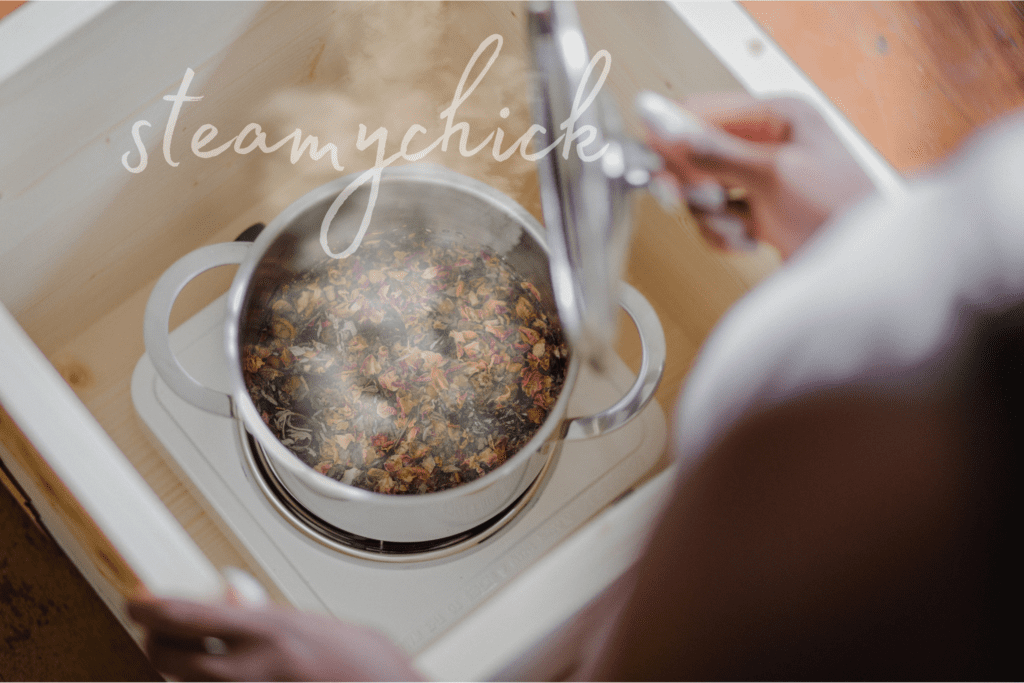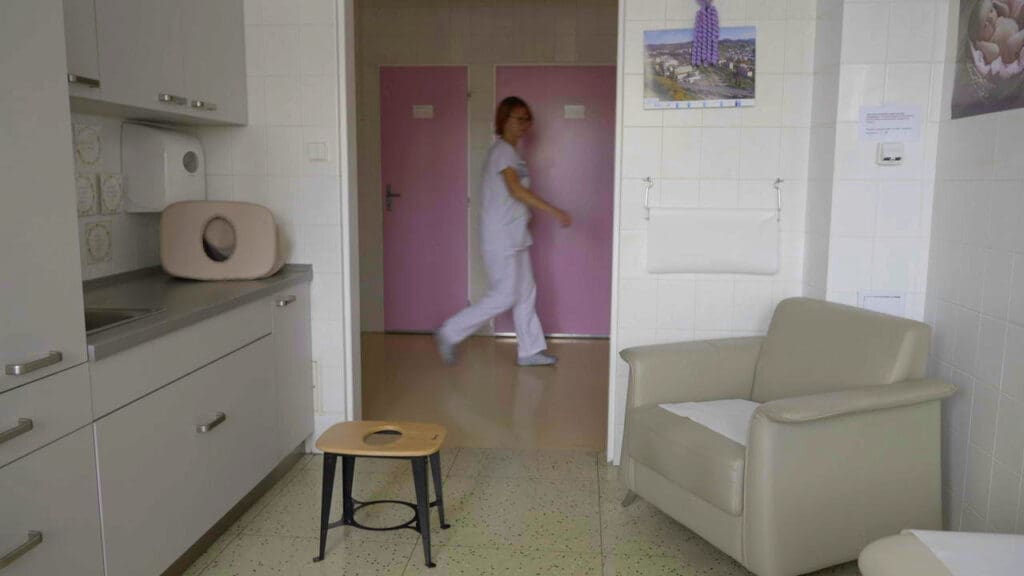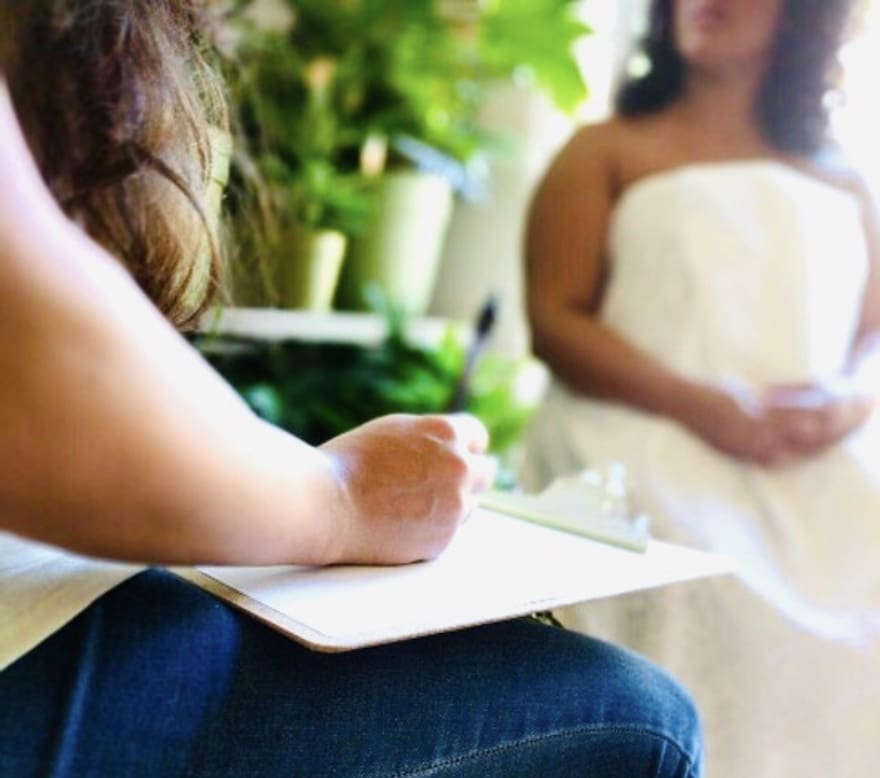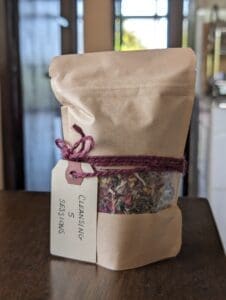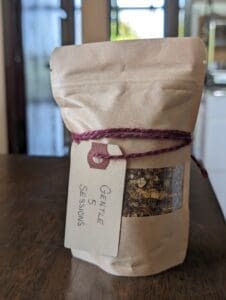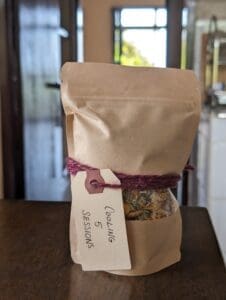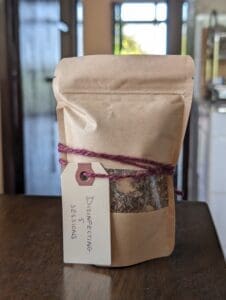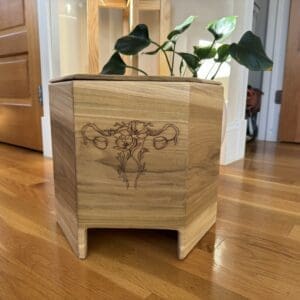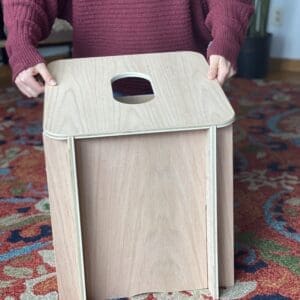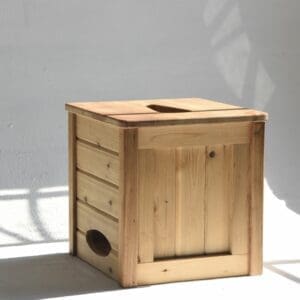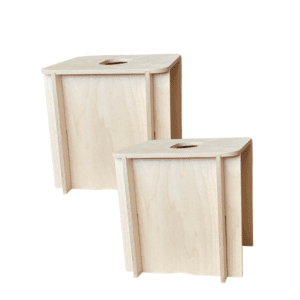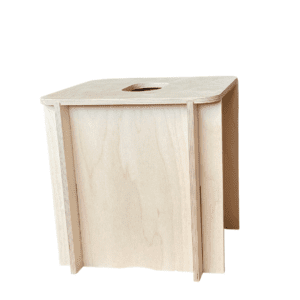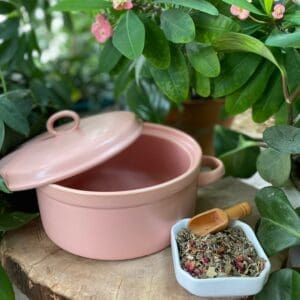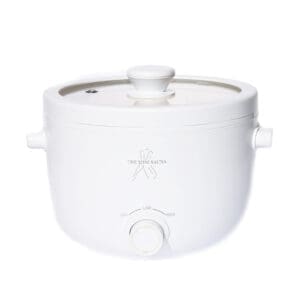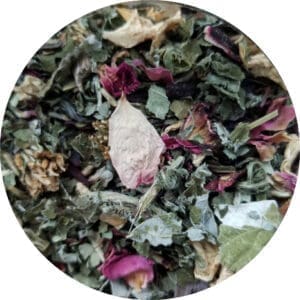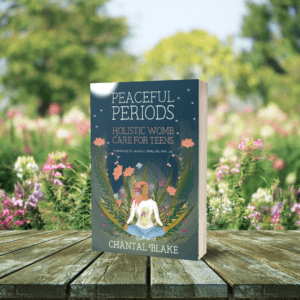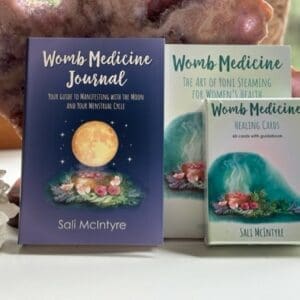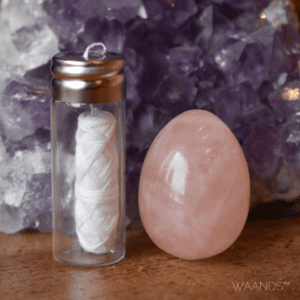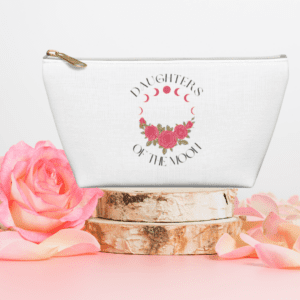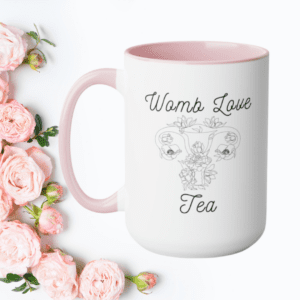For feminine hygiene, we recommend a self-care routine of vaginal steaming after the menstrual period and washing the vulva with water. A handheld showerhead is helpful for efficient cleaning while showering. We also encourage the use of a bidet or spray bottle/peribottle after using the toilet. Steaming herbs can also be made into a rinse and used for freshness.
Q&A
Reflections from the steam box.
The process of steaming itself may encourage an emotional release or healing experience. When it comes to herbs, their therapeutic effect on your period takes precedent over their potential effect on your emotions. The best approach is to use an herb formula based on what is needed for your menstrual cycle.
Seek out an intake with a Peristeam Facilitator for help determining the best herbs as well as steam setup and duration.
It is not yet known how vaginal steaming impacts autoimmune diseases. However, if you have an autoimmune disease, you don’t also want to be dealing with uterine and menstrual issues. In general, when one organ of the body is out of balance, it can affect the rest of the body. In that way, steaming for uterine health would likely be good for your overall condition, especially since the cause of autoimmune diseases is unknown.
Steaming can always be done on a weekly basis to help support the overall menstrual cycle. It may also be useful to do a consultation to determine your menstrual cycle imbalances and get a specific steam plan for your unique circumstances.
If interested in this option, you can find a practitioner through the Vaginal Steam Directory at steamychick.com.
None to our knowledge.
I heard of a steam user once who used it for infections and said she had great results. I do not know more details.
In this case, it would be useful to work with a practitioner trained in working with stagnation. A consultation with a Peristeam Hydrotherapist would be recommended.
Steaming definitely helps with vaginal dryness and dry skin. It doesn't necessarily help with skin discoloration.
If steaming is not contraindicated for you, it is worth trying.
A steam box can be wiped down or rinsed with diluted hydrogen peroxide, apple cider vinegar, alcohol, essential oils, cleansing smoke or other disinfecting agents between users.
The consensus among partners of steam users seems to be yes.
For some women, menstrual cups cause stagnation, pain, cramping or clotting; while for others, it does not. It is important to observe the changes in your period and decide which period product works best for you.
Libido enhancement is an often reported positive side effect of steaming.
Steaming is not recommended within the first six weeks following a hysterectomy. After the initial healing phase, steam users have reported improvement with scar tissue, elimination of unexplained brown or irregular discharge, improved vaginal lubrication and less discomfort during intercourse. Some also report that steaming provides psychological comfort and increased connection with feminiity after the loss of their primary female organ.
There have been cases of partial hysterectomy where vaginal steaming has been helpful with resolving ovarian cysts.
Any method of birth control that relies on the presence of scar tissue to prevent conception, such as tubal coagulation, may be compromised by vaginal steaming. Steam, by its nature, helps to dissolve and soften scar tissue which could potentially affect the efficacy of tubal coagulation as birth control
Steaming has shown helpful for all ages, including the years approaching menopause. Any unresolved menstrual imbalances can be exacerbated as one experiences hormonal changes with age.
A balanced menstrual cycle can help to avoid premature menopause and help symptoms associated with menopause and postmenopause such as nightsweats, hot flashes, vaginal atrophy, low libido and poor sleep.
It is recommended to do a menstrual cycle analysis with a Peristeam Hydrotherapist to determine if there are any underlying menstrual imbalances and to initiate a steam plan to help balance the menstrual cycle.
In a case where there has been an operation, you will want to work with a steam practitioner to determine when it is safe to begin steaming as well as selecting the appropriate herbs, duration and schedule.
in general steaming can usually start six weeks post-operation.
When the menstrual cycle length is short (less than 28 days between the start of consecutive periods), a hemostatic herbal formula is recommended.
Steaming can not be relied upon as a method of birth control. Many people steam after ovulation, not yet knowing they conceived, and do not experience pregnancy loss.
If one were to attempt the use of vaginal steaming to prevent potential conception after unprotected sex, they would need to steam as soon as possible after insemination for three times a day with cleansing herbs for at least three days in a row for 45 minutes each steam session.
Please note, however, that steaming with this frequency may cause side effects and will very likely cause unexpected period changes for most people. It is best done under the guidance of a practitioner trained in this area.
Also keep in mind that there is no guarantee that this steam plan will prevent pregnancy or initiate a period.
There are a couple ways to figure out which herbs would be most suitable for you: 1) complete the free Steamy Chick Do-It-Yourself Tutorial at steamychick.com. 2) consult with a practitioner. 3) complete the Vaginal Steam Faciltiator Certification course which includes instruction in how to screen yourself and make herbal formulas.
1) Do an intake form with a Peristeam Facilitator .
2) Take the first two courses of the Peristeam Facilitator certification which includes the module Easy-to-Make Vaginal Steam Herb Formulas and features a list of steam herbs and properties.
There is some mounting evidence in the form of individual testimonials and case studies to suggest that vaginal steaming positively impacts cervical/ovarian cancers and fibroids. To our knowledge, only one study in China has looked at steaming as a treatment for cancer and aggressive human papillomavirus (HPV), in addition to chemotherapy.
What the study found was that there was a higher survival rate among the patients who underwent both chemotherapy and steam sessions
Vaginal discharge after steaming is an expected outcome, as steam liquidizes mucus and congealed phlegm. If either is present in the reproductive organs, they will often drain out within 24 hours after a steam session.
In general, it is great to work with a practitioner at first to be able to ask such questions. While a lot of internet resources recommend steaming as a DIY home practice or a spa treatment, there are a lot of physiological changes that might occur and it is ideal to work with someone who is experienced. Being under the guidance of either a Peristeam Facilitator or Peristeam Hydrotherapist who knows all of the signs to expect and when to make adjustments to the plan is really great for one to three months while getting started with a steam regimen.
For example, there are more things to expect as well - more clots during the menses which require proper period care protocols in order to make sure the steaming works how it is supposed to.
For users with an intrauterine device (IUD), it is recommended to only steam for 10 min and no longer. Steaming longer might cause IUD displacement.
Steaming is contraindicated in the case of a possible pregnancy.
Steaming may potentially open the cervix which would be unsafe in early pregnancy.
If someone is actively trying to conceive and post insemination or transfer in the case of IUI/IVF, steaming would not be advised until it is confirmed the user is not pregnant.
Essential oils are not recommended for vaginal steaming, as they are highly concentrated in strength and can be irritating or drying to delicate tissues. It is best to work with fresh or dried whole herbs.
Whole fruit would not be recommended for vaginal steam water because of the sugar in it, however citrus peels and berry leaves are okay.
Steaming is contraindicated when experiencing any fresh, red bleeding which includes menstruation and spotting. It is also contraindicated during pregnancy. There are also some medical and excess heat contraindications.
If unsure it is best to do an intake form with a certified Peristeam Facilitator that screen for contraindications as well as steam sensitivities and can make sure each person has the right steam setup and herbs based on their needs.
Steaming during menstruation is contraindicated, unless the menstrual flow is exclusively brown or black. If there is a foul odor during any other time of the menstrual cycle, steaming would be helpful.
In general, you may want to try steaming three days in a row before and after the menstrual cycle.
Yes. However, it is recommended to do this under the guidance of a steam practitioner or birthworker trained in this area or to complete a course in this practice before doing so.
More Information:
Vaginal Steaming for Labor Prep
steamychick.institute/ph08
It would be best to consult with an esthetician about this.
There is no need to delay intercourse after steaming.
Yes definitely. Vaginal steaming can be helpful for infections; however, safety measures must be considered. Infections are a sign of a heat sensitivity which means that while steaming, the steam set up should always be mild, meaning without a sustained heat source. Cloaking should be avoided and herbs should be prescribed based on the nature of the infection and how it presents in the individual. The herbs will vary based on whether the infection is of a dry nature or a damp nature. Steam sessions should not exceed 10 min in duration and may need to be shorter in certain cases.
It is advised to do a consultation with a Peristeam Hydrotherapist for a steam schedule that will hopefully get rid of the infection and help prevent it from coming back, or at least reduce the severity of future outbreaks. Clients usually need at least one to three months consecutive work with a Peristeam Hydrotherapist for this outcome.
As soon as fresh red menses or spotting ends, you can begin steaming. If there is only brown blood, steaming can help clear it out, but should be discontinued if a fresh red blood flow resumes.
Steaming to address pregnancy loss is intricate. There are 3 distinct phases: impending pregnancy loss, active pregnancy loss and post pregnancy loss. Steaming can be done in the first and third phases, but not during the second. During any phase of pregnancy loss, steaming should not be done if there is any fresh red bleeding, unless the user is working under the direction of a steam practitioner. It is common for someone to start steaming after a miscarriage appears to be complete and then see more pregnancy matter clear out, so it is also useful to have a practitioner who can help navigate this. Some days may be safe to steam while others may not be. If there is one situation that it would be worth the investment to work with a practitioner and do a consultation, this would be the time. It is not advised to initiate pregnancy loss steaming on your own without training or supervision.
Steaming itself increases circulation and therefore uterine function which should be helpful to clear out the clots and brown discharge you described.
Regarding herb selection, this is determined based on the Period Profile which takes into consideration menstrual cycle length and sensitivities such as uterine bleeding or excess heat.
There are a couple ways to figure out which herbs would be most suitable for you: 1) Do an intake form with a certified Peristeam Facilitator, 2) complete the Peristeam Faciltiator Certification which will instruct you how to screen yourself, determine the best formula and make herbal formulas. Once you have the right herbs, they will naturally help to balance out your menstrual cycle which is helpful for fertility purposes.
For fertility prep, it is also recommended to do a consultation with a Peristeam Hydrotherapist in order to determine if you have any menstrual cycle imbalances other than the stagnation you described and to create a conception steam plan and schedule.
Frequency of steaming depends on the individual and their unique circumstances. Some people will need to steam daily, while others need only steam once per month to avoid undesireable period changes or side effects. Other people cannot steam at all. This can initially be determined by an intake with a Peristeam Facilitator who can craft a steam plan that matches your menstrual and reproductive constitution (aka Period Profile). In addition to the frequency of steaming, it's also important to have the right setup, steam duration and herbal formula.
You should not steam with yoni pearls in. I would imagine it best to use them prior to or after a steam session.
Yes. 1.5 teaspoons of sea salt/Himalayan salt can be added to 1.5 liters of water used for steaming.
Yes. 1 tablespoon pf apple cider vinegar can be added to 1.5 liters of water used for steaming.
From case study observations, vaginal dryness seems to improve relatively easily with vaginal steaming. Steaming on a weekly basis would be highly recommended.
If you don’t feel like the issue is completely resolved or there are other issues you’d like to target, you can find a practitioner for a more tailored steaming protocol through the Vaginal Steam Directory.
Using herbs sourced from your own garden is an empowering way to start your steam journey. However, it is helpful to know the effects of different herbs on the menstrual cycle and how they can potentially affect your menstrual cycle.
Practitioners trained by the Steamy Chick Institute are trained in an herb blending methodology that produces balanced formulas with circulatory, blood tonic, moisturizating, digestive aid and aromatherapeutic herbal properties. Additionally, some blends will need anti-hemorrhagics and qi tonic properties, while others may need more neutral or cooling herbs depending on what is indicated. Practitioners must be capable of producing four distinct types of steam blends--Cleansing, Hemostatic, Disinfecting and Cooling-- and know when to recommend them appropriately.
While you are free to experiment with herbs for yourself as you like, you should also consider at least the first two courses of the Peristeam Facilitator certification (which includes the module Easy-to-Make-Vaginal Steam Herb Formulas) before offering to support anyone else through the practice of steaming.

